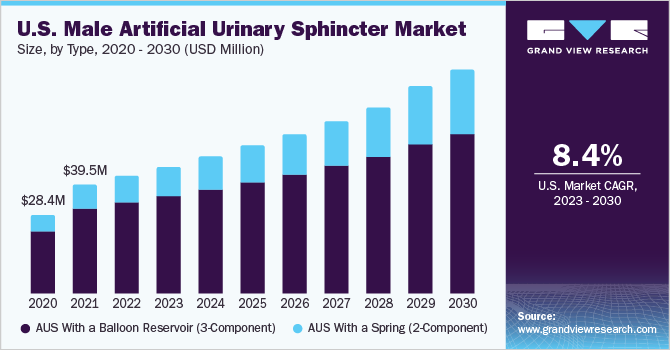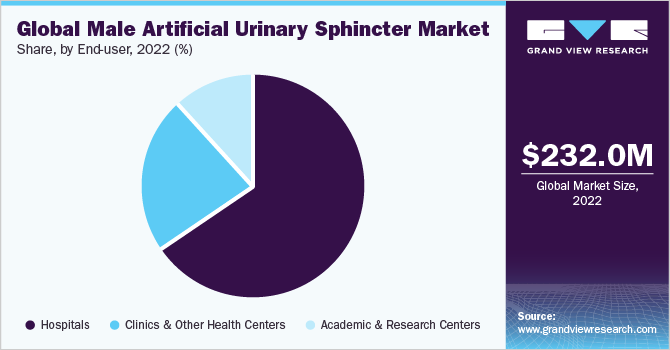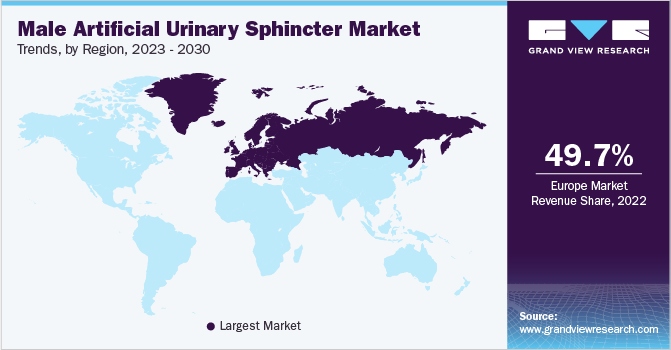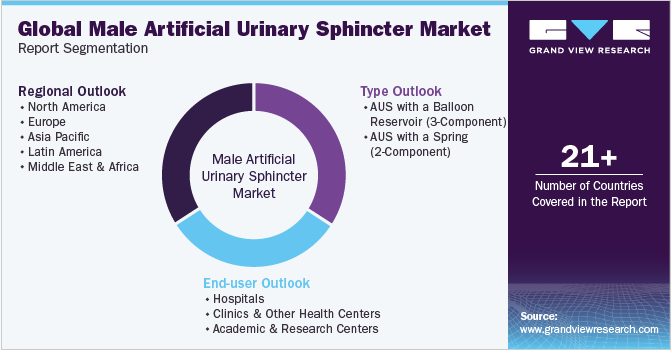- Home
- »
- Medical Devices
- »
-
Male Artificial Urinary Sphincter Market Size Report, 2030GVR Report cover
![Male Artificial Urinary Sphincter Market Size, Share & Trends Report]()
Male Artificial Urinary Sphincter Market Size, Share & Trends Analysis Report By Type (AUS With A Balloon Reservoir (3 Component), AUS With A Spring (2 Component)), By End-user, By Region, And Segment Forecasts, 2023 - 2030
- Report ID: GVR-4-68040-112-4
- Number of Report Pages: 161
- Format: PDF, Horizon Databook
- Historical Range: 2018 - 2021
- Forecast Period: 2023 - 2030
- Industry: Healthcare
Report Overview
The global male artificial urinary sphincter market size was valued at USD 232 million in 2022 and is projected to grow at a compound annual growth rate (CAGR) of 6.40% from 2023 to 2030. The market is primarily driven by factors such as the increasing prevalence of urinary incontinence globally, growth in healthcare expenditure in developing countries, and technologically advanced solutions such as smart and adjustable artificial urinary sphincter (AUS) devices with a wide range of cuff sizes. Rising medical needs due to patients suffering from urological diseases, stronger demand for innovative products and therapies, and advancements in medical technologies are expected to further add to the market growth post-COVID-19.

Urinary Incontinence (UI) is a major health issue that has a significant economic and social impact. The growth in male urinary incontinence is driven by the rising prevalence of urological disorders, such as urinary incontinence caused by prostatitis, injury or damage to nerve muscles from surgery, and infections, among others, which lead to bladder dysfunction. An enlarged prostate gland can cause benign prostate hyperplasia, an age-related condition where the prostate grows in size. Another potential cause is prostatitis, which is inflammation of the prostate gland. In addition to these two factors, incontinence can result from nerve and muscle damage associated with surgeries.
According to an article published by ICUROLOGY in January 2022, the prevalence of incontinence in men is considerably higher compared to women, ranging from 3% to 11%. Urge incontinence accounts for around 40-80% of males suffering from urinary incontinence. In addition, stress UI represents less than 10% of cases and is typically caused by trauma, prostate surgery, or nerve injury. Incontinence in men also increases with age, although the prevalence of critical incontinence in men aged 70-80 is half of that in women.
Technological advancements have progressed the scope of laparoscopy in the urology field. The development to treat urological disorders is progressing globally. Robot-assisted surgeries have gained considerable momentum since the COVID-19 period, owing to the necessity to maintain physical distance from other individuals and increasing number of patients with urological disorders. A robot-assisted laparoscopic positioning of bladder neck artificial urethral sphincter (Robot-AUS) is performed on AMS-800 AUS. This method is preferred compared to the conventional approach as it allows for an outstanding imagining of the posterior dissection.
Moreover, the growing preference for minimally invasive treatments in urology is significantly impacting the demand for male AUS devices globally. These procedures are performed through small incisions or natural orifices, such as the urethra, using specialized tools and instruments. These treatments are associated with less pain, reduced scarring, shorter hospital stays, and faster recovery times. As a result, they offer a safer and less invasive alternative to traditional open surgery, with improved patient outcomes.
Type Insights
The AUS with a balloon reservoir (3-component) segment accounted for the largest market share with 77.4% in 2022. An artificial urinary sphincter with a balloon reservoir is a 3-component device that is commonly used to treat patients with urinary incontinence. The balloon reservoir acts as a storage compartment for fluid (saline is commonly used) that is used to inflate or deflate the cuff surrounding the urethra to control the urine flow.
The AUS with a spring (2-component) segment is expected to exhibit the fastest growth rate during the forecast period. ZSI 375, developed in 2008 by Zephyr Surgical Implants, is the most commonly used AUS with a spring. This AUS does not have an abdominal component and has a ready-to-implant configuration that reduces implantation time. Moreover, surgical interventions are not required in the retroperitoneal space due to the absence of an abdominal component. It also allows an increase or decrease of the pressure inside the device post-implantation to get the required continence rate. These advantages are expected to propel their demand in the near future, contributing to the increased market share in terms of sales.
End-user Insights
The hospitals segment dominated the male artificial urinary sphincter market with a 65.3% revenue share in 2022. This dominance can be attributed to the increasing number of surgical procedures and a rise in cases of end-stage renal diseases. For instance, according to the CDC, in 2021, around 786,000 individuals in the U.S. received treatment for end-stage kidney disease, with approximately 71% on dialysis and 29% having undergone kidney transplants.

The clinics and other healthcare centers segment is projected to expand at a substantial CAGR of 7.47% during the forecast period. These clinics are equipped with the required equipment and infrastructure. Ambulatory Surgery Centers (ASCs) are dedicated surgical facilities that specialize in offering emergency or same day surgical procedures and are often connected with a larger healthcare system. ASCs can offer a wide range of surgical procedures, including UI surgeries such as sling procedures, AUS implantation, and others.
Other healthcare facilities or centers include specialty surgical clinics, urology clinics, hospital-based clinics, and non-profit healthcare systems.Moreover, clinics offer more cost-effective options compared to hospitals for urological surgeries. As outpatient facilities, such clinics have lower overhead costs, and do not require overnight stay, which can reduce the overall expense for the patient. They also have shorter waiting time and patient-centric approach, and often have specialized teams of urologists, nurses, and staff who are highly experienced and skilled in urologic surgeries.
Regional Insights
Europe dominated the market in 2022 with a revenue share of 49.7%. Advanced healthcare has resulted in longer life expectancy in Europe, which has further led to a growth in the aging population. One in five people in Europe are aged 65 and above. The aging population is prone to urinary incontinence (UI). Additionally, the cost of having surgery to correct UI is much higher for individuals. All these factors have led to Europe being in the dominant position in terms of revenue contribution to the artificial urinary sphincter market in 2022 and will continue to do so during the forecast period.

The North American market for male artificial urinary sphincters is expected to grow at a lucrative rate over the forecast period. Due to its well-developed healthcare system, high prevalence of urological disorders, and a strong emphasis on technological improvements in medical devices, the North American region is a prominent market for male artificial urinary sphincters. Several urological diseases, such as kidney stones, enlarged prostates, bladder tumors, and urinary tract strictures, are diagnosed & treated with advanced treatments, including implantation of male artificial urinary sphincters.
AUS has a long history of user success in the United States. Moreover, AMS 800, which is an AUS device by Boston Scientific Corporation, has been approved by the U.S. Food and Drug Administration (FDA), which ensures the safety and effectiveness of the devices among users. It is also covered by insurance companies, making it more affordable and accessible for patients in the region.
Key Companies & Market Share Insights
Major players contributing to the market for male artificial urinary sphincters utilize strategies such as new product launches, distribution agreements, and product innovations, among others, to retain their market share. For instance, in May 2020, Rigicon, Inc. globally launched its Conti AUS portfolio with two products, ColtiClassic and ContiReflex AUS. Both products received CE Mark Approval and were made available in European markets. Some of the prominent players in the global Male Artificial Urinary Sphincter market include:
-
Boston Scientific Corporation
-
Zephyr Surgical Implants
-
Affluent Medical
-
UroMems Inc.
-
Rigicon, Inc
-
Promedon GmbH
Male Artificial Urinary Sphincter Market Report Scope
Report Attribute
Details
Market size value in 2023
USD 245.83 million
Revenue forecast in 2030
USD 379.55 million
Growth rate
CAGR of 6.40% from 2023 to 2030
Base year for estimation
2022
Actual estimates/Historic data
2018 - 2021
Forecast period
2023 - 2030
Quantitative units
Revenue in USD million/billion & CAGR from 2023 to 2030
Report coverage
Revenue forecast, competitive landscape, growth factors & trends
Segments covered
Type, end-user, region
Regional scope
North America; Europe; Asia Pacific; Latin America; MEA
Country scope
U.S.; Canada; UK; Germany; France; Italy; Spain; Denmark; Sweden; Norway; China; Japan; India; Australia; South Korea; Thailand; Brazil; Mexico; Argentina; South Africa; Saudi Arabia; UAE; Kuwait
Key companies profiled
Boston Scientific Corporation; Zephyr Surgical Implants; Affluent Medical; UroMems Inc.; Rigicon, Inc.; Promedon GmbH
customization scope
If you need specific market information, which is not currently within the scope of the report, we will provide it to you as a part of the customization
Global Male Artificial Urinary Sphincter Market Report Segmentation
This report forecasts revenue growth at the global, regional, & country levels and provides an analysis of the latest industry trends in each of the sub-segments from 2018 to 2030. For the purpose of this study, Grand View Research has segmented the global Male Artificial Urinary Sphincter market report on the basis of type, end-user, and region.

-
Type Outlook (Revenue, USD Million, 2018 - 2030)
-
AUS with a Balloon Reservoir (3-Component)
-
AUS with a Spring (2-Component)
-
-
End-user Outlook (Revenue, USD Million, 2018 - 2030)
-
Hospitals
-
Clinics & Other Health Centers
-
Academic & Research Centers
-
-
Regional Outlook (Revenue, USD Million, 2018 - 2030)
-
North America
-
U.S.
-
Canada
-
-
Europe
-
UK
-
Germany
-
France
-
Italy
-
Spain
-
Denmark
-
Sweden
-
Norway
-
-
Asia Pacific
-
China
-
Japan
-
India
-
Australia
-
South Korea
-
Thailand
-
-
Latin America
-
Brazil
-
Mexico
-
Argentina
-
-
Middle East & Africa
-
South Africa
-
Saudi Arabia
-
UAE
-
Kuwait
-
-
Frequently Asked Questions About This Report
b. The global male artificial urinary sphincter market was estimated at USD 232 million in 2022 and is expected to reach USD 245.83 million in 2023.
b. The global male artificial urinary sphincter market is expected to grow at a compound annual growth rate of 6.40% from 2023 to 2030 to reach USD 379.55 million by 2030.
b. Europe dominated the male artificial urinary sphincter market with a share of 49.72% in 2022. This can be attributed to the strong presence of companies engaged in developing, manufacturing, and commercializing devices used for treating urological patients in the region.
b. The growth of the male artificial urinary sphincter market is due to various factors such as advancements in surgical techniques, increasing prevalence of urological disorders, a growing aging population, and ongoing research and development in medical technology. Additionally, factors like regulatory approvals, healthcare infrastructure, and reimbursement policies also play a significant role in the market growth.
b. Some key players operating in the male artificial urinary sphincter market include Boston Scientific Corporation, Zephyr Surgical Implants, and others.
Share this report with your colleague or friend.
![gvr icn]()
NEED A CUSTOM REPORT?
We can customize every report - free of charge - including purchasing stand-alone sections or country-level reports, as well as offer affordable discounts for start-ups & universities. Contact us now
![Certified Icon]()
We are GDPR and CCPA compliant! Your transaction & personal information is safe and secure. For more details, please read our privacy policy.
We are committed towards customer satisfaction, and quality service.
"The quality of research they have done for us has been excellent."





